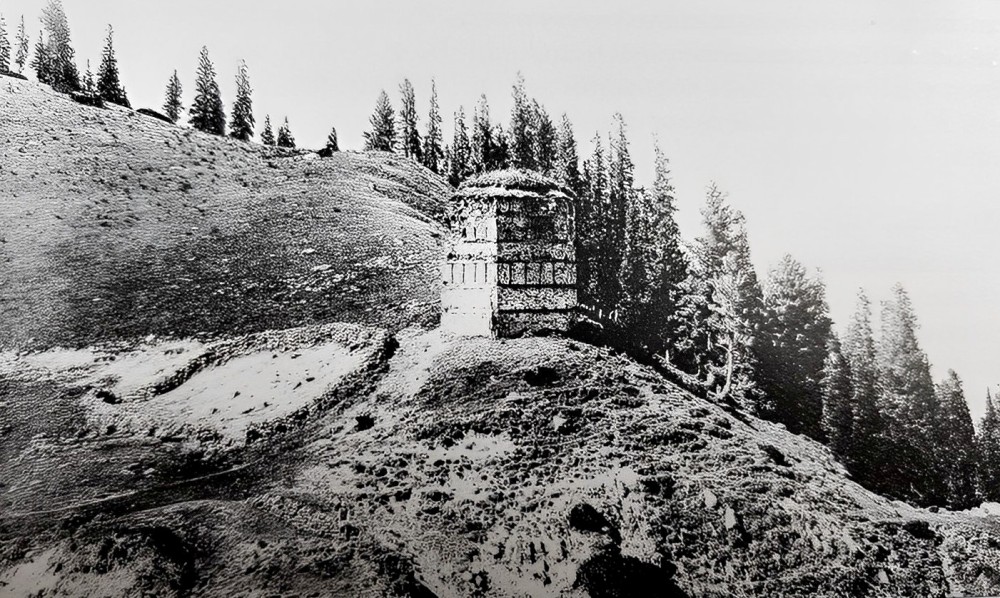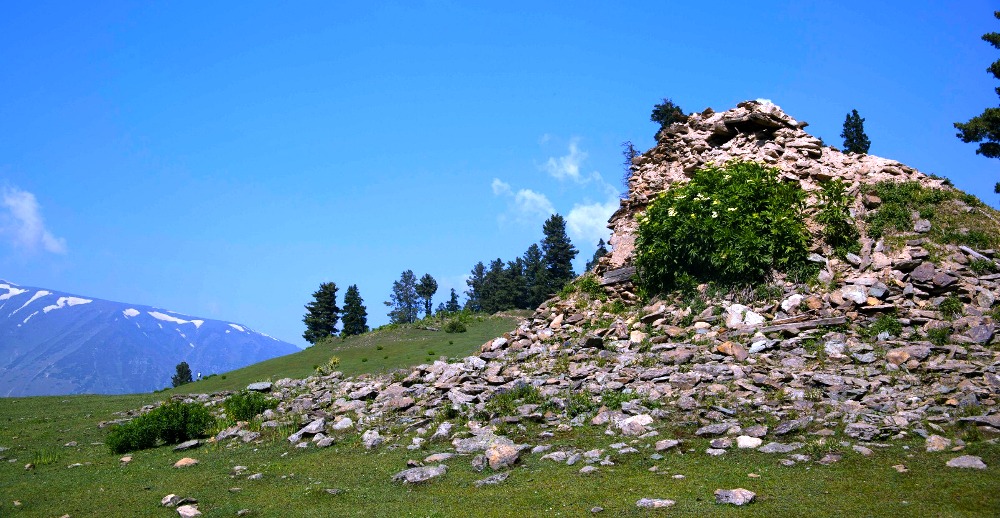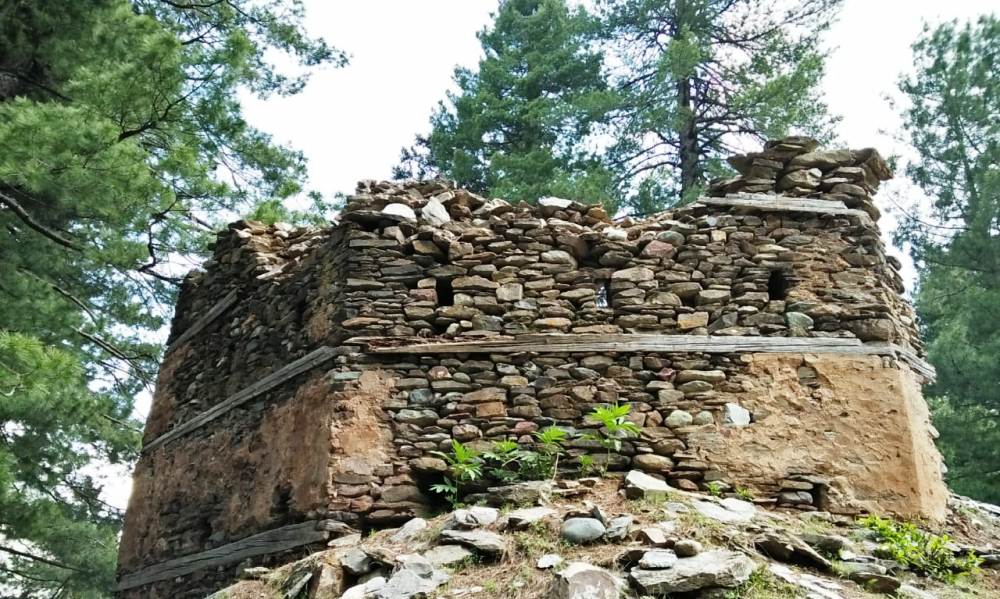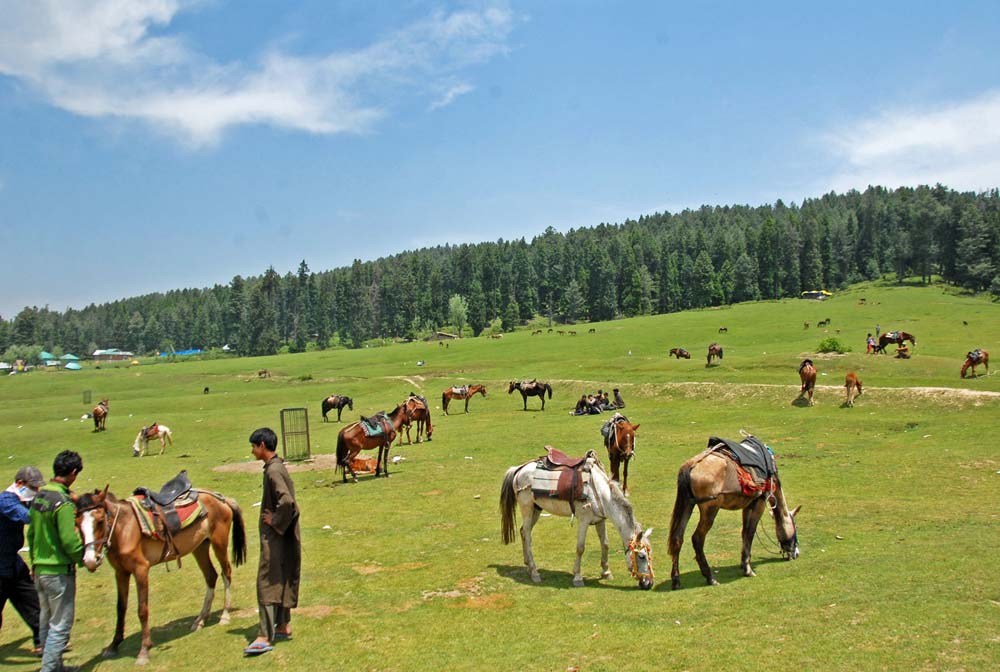[ad_1]
On two sides of the Pir Panchal mountains in Budgam live a community that shares ethos, language and heritage. For centuries, they have been marrying their wards and reaching each other by foot using the same route that traders and conquerors used in early medieval Kashmir. Now, they want a 10-km road that will end their centuries of crisis, reports Abul Aala Bukhari

Raja Begum was born in Loran’s Barichaid belt, which is nestled in the Poonch peaks in the Pir Panchal range. Now in her old age, she is settled and married in Budgam’s Drung area for many decades. Interestingly, her son and daughter are both married in Loran.
The two villages inhabit the foothills of the same mountain range on two sides and the residents trek the distance within hours. Throughout history, they have been together in every crisis, a relationship that they have retained even today.
= The erstwhile Poonch principality, now a district, is a huge mountain territory. It literally surrounds most of Kashmir and is accessible from Uri, Tangmarg Budgam and Shopian.
Writing in 1897, De Bourbel detailed various treks that people could use in reaching Kashmir from Poonch. One was Poonch Baramulla through the 9135-ft Gajjan Pass, which was challenging and passed through Bitarh and Sakarala valleys and camps at Kahuta, Palan, Hillun, Gujan, Gaggerhil, and Bhunniar.
From Poonch, Gulmarg is accessible through Nilkant Pass, which almost takes the same trek but moves away from Hillun towards Dangar Allan, Pharpat Marg and then to Gulmarg.
Parallel to this trek, runs another route that connects Srinagar with Ferozpur Pass. It takes off from Mandi (Koondah) , moves to Gurgi Upper, reaches Banabali Nag, and then to Magam via Gerozpur pass. From Gurgi Lower, another route takes off for Srinagar that touches Shinamani, Dunwas, Aripanthan, Soibug and Srinagar.
The closest to Srinagar continues to be the Tosa Maidan access. This trek used to take off from Mandi in Poonch, cross Sultan Patri and land in Tosa Maidan. Running parallel to it is another trek that passes through Doodh Pathri.
There are two formal roads between the two areas – one through Uri, which is defunct because Haji Pir pass is inaccessible to the two sides, and the Mughal Road, which is operational for many years now. Laid in the early forties, the 46 km road connecting Uri with Poonch through the strategic 9000-feet Haji Pir Pass was operational till late 1947 and later for a few months after the 1965 war as well. After India wrested the strategic Haji Pir Pass from Pakistan in 1965, the road was used by Mrs Indira Gandhi and convoys would use it from Uri to Poonch. But Tashkent restored the status quo ante and the road was closed again.
Besides, Poonch is easily accessible from Tangmarg and Tosa Maidan. This accessibility has helped the people living on either side to have relations with each other. Begum is only one of the many hundred women who are settled in Kashmir.
All these tracks were always guarded for any entry or exit. These were the border checkposts. These were called Dumdums in medieval Kashmir and in certain cases were multistory towers. Though most of them have crumbled and disappeared, the ruins of a few are slightly intact. Trekker and mountaineer Mehmood Shah, who is also a brilliant photographer, has captured at least two such Dumdums -one in Hirpora (Shopan) and another at Danwas (Tangmarg). The Danwas watchtower was undone by time but the one at Hirpora had still a perfect base.

There are scores of women from Poonch who are married in Drung and other adjoining Kashmir areas and vice versa. The familial relations connecting many villages in north and central Kashmir with Pir Panchal’s villages comes even when the proposals of successive governments to revive traditional routes could see the light of day.
In summer, Begum said she goes to her parent’s home via China Mar Gali in Tosamaidan, an access that takes barely five hours on foot. In winter, however, if she requires going, it takes her a long time to use the Mughal Road and if it is closed, it requires three days to reach Poonch via Jammu.
Begum said the marriages are solemnised across the villages on both sides as people of the same castes live on both sides. “Due to our social norms, we don’t marry outside our community and that is why we marry among our people across the mountains,” she said.
These marriages have been taking place in a vast belt on either side. Brides from Poonch can be seen in Khag, Zubjan, Brass, Satrun, Beerwah, Arizal, Raithan, and various Khan Sahab areas. Girls from these villages also settle on the other side of the mountain range. These relations have made the administrative division unimportant. Poonch falls in the Jammu division and Budgam is a Kashmir region district.
“My father was a contractor and was working in Poonch where he married my mother in Sonpha,” Maqbool Ahmad, Raja Begum’s son said. “Later he came with his wife and settled in Kashmir; Now I am married in Poonch and so is my sister.” He said marriages take place because people share the same caste and the same culture. “They also speak the Kashmiri language.”
For Maqbool and many others, the preference is the Poonch side bride rather than Kashmir. “There are only two factors responsible for this,” Farooq said, “one is our shared cultural heritage and another is simple marriage.” He said the marriages are taking place from both sides. “It is not a one-way affair and it is not linked to resources,” he added.
= Athamsham Butt said that three areas of Poonch – Loran, Sawjikm, and Mandi – have more than half of the population having Kashmir origins. Their elders migrated to Poonch for trade and business and settled there. All these areas speak Kashmiri.
Ethnic Kashmiris marry in Kashmir. In their weddings, they have almost everything that happens in Kashmir but these marriage ceremonies are less expensive, simple and devoid of mouth-watering Wazwaan.
Most of the weddings, however, avoid moving on foot. These baraats choose Mughal Road instead. For most of their life later, they usually move on foot because it is cheap and a huge time-saving.

Off late, the people living on the two sides of the mountain range have been seeking s road link that would connect Loran and Budgam via Tosamaidan.
In 2015, the Mufti Sayeed-led BJPDP government started work on a road in the Tangmarg area of Baramulla which would connect with Loran in Poonch. However, the work on the road couldn’t be completed. The responsibility of constructing this road was given to the Border Road Organisation (BRO). The work was started with much fanfare but to date, only 12 kilometres were completed out of a total of 38 kms.
Shah Mohammad Tantray, a former PDP lawmaker from the area said that in 2018 he enquired about the progress of the project which led to his “disappointment” when he was informed that the work has been stopped.
“The men and machinery of the construction company also fled away.”
Tantray alleged that post August 5, the union government has stopped construction works undertaken by the previous coalition government across Jammu and Kashmir.
The previous government, Tantray said, had conducted an aerial survey for a cable car project aimed to connect Loran with Tosamaidan. “The Tosamaidan and Loran are just 2.5 kilometres away as per the aerial survey. It just takes five hours to walk on foot. It is just a mountain separating Loran from Tangmarg.”
Poonch resident, Ahtesham Butt said that the work on Loran to Tangmarg road and adjacent areas of Tosamaidan was started but was suddenly stopped due to reasons unknown.
“Locals thought that this road would provide employment opportunities to young educated people along with boosting tourism,” Butt said. “If this road comes up, people wouldn’t opt for the Mughal Road.”

Shabir Ahmad, a local resident of Sutran Budgam said a road from Tosamaidan to Loran is shorter than the one being laid to connect Loran via Tangmarg. “This road is barely 10 kms from Tosamaidan to Loran and its stations in between are Damdam, Kadlabal, Habas, Gartar, Damsar, Bandarsar, and Sultanpathari areas,” Ahmad said.
There has not been any spade work on the link connecting Budgam with Loran. In September 2007, when the Mughal Road was being implemented, the then Chief Minister Ghulam Nabi Azad said there is a much shorter road that must be taken up. Talking to a huge gathering in Poonch’s Loran, Azad said he has asked his Roads and Buildings department to go for a quick survey of the 42-km Loran (Poonch) Arizal (Budgam). “It is the shortest road link between Kashmir and Poonch,” he said.

This road that the people are so keen to have properly laid and developed is not a new route between Poonch and Kashmir. It is actually one of the oldest that conquerors and traders used for centuries. This route was used by Mehmood Gaznavi more than once to capture Kashmir. He failed every time.
During the Shah Miri rule, Sultan Fathe Shah ran for life to Poonch using this route. Later in the 15th century, Yousef Shah Check returned home from Delhi using this trek.
It was a trade route too. It was a formal entry point into Kashmir. Till the1960s Salt was transported into Kashmir from this route. Some people still know this trek as the Nun Wath, the Salt Road.
Javid Ahmad Farash, a resident of Lassipora Drung said that there is a structure erected at Tosa Maidan whose ruins can still be found there. That, he said, was the custom post having a seven-story building. All the entries and exits used to be recorded there and taxes were also paid, he said.
In 1964, the Tosa Maidan meadow was leased to the Army on a 50-year lease for use as an artillery firing range. Before the lease came up for renewal on April 18, 2014, the lease was terminated, and the Tosa Maidan meadow is open to visitors since May 30, 2016. Now, it is a busy picnic spot for most of the summer.
[ad_2]
#Reviving #Route
( With inputs from : kashmirlife.net )









